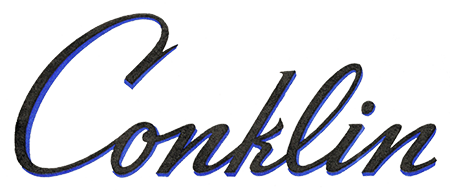Conklin Nozac Penline 1936–37
by Jim Mamoulides, January 31, 2023
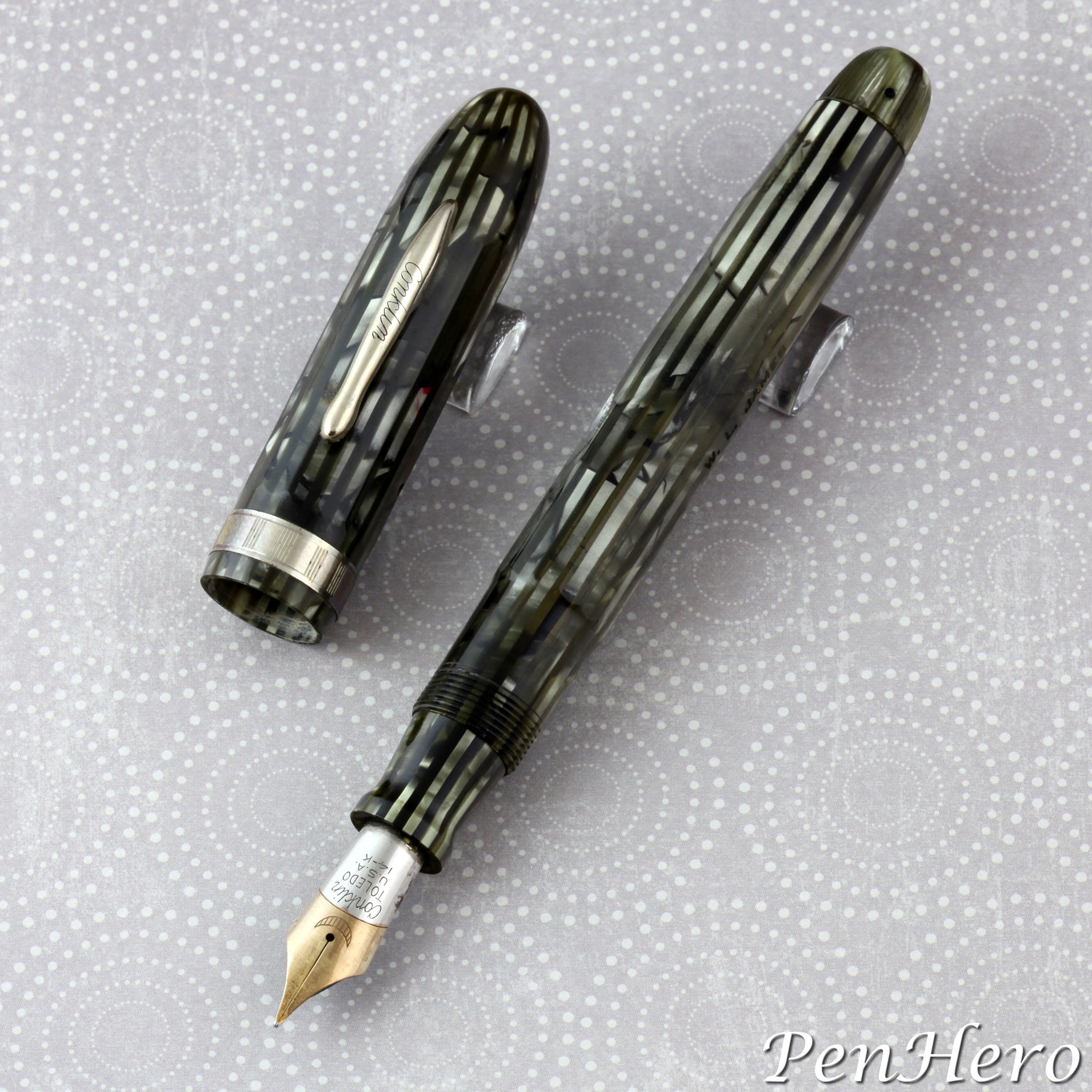 Conklin Nozac Penline Gray Pearl c. 1936
Conklin Nozac Penline Gray Pearl c. 1936
America’s Striped Piston-Filler
In 1929, the majority of self-filling fountain pens used various methods to compress a rubber ink sac inside the barrel using levers, pressure bars, and pneumatic mechanisms. Ink capacity was limited by the size of the sac and how efficiently the system could fill it. Although eyedropper pens could hold more ink, storing it directly in the barrel, they were inconvenient to refill and by this time were out of favor. Patents show that pen companies during the 1920s and 1930s actively sought improvements in filling convenience and capacity, including ways to directly use the larger capacity of the barrel and to see into the pen to check the remaining ink level.
Theodor Kovács developed and patented a piston-filling mechanism that uses a differential spindle gear. The patent was awarded in September 1926 in Germany and then sold in 1927 to the Günther Wagner Company of Hanover, Germany. Günther Wagner re-patented the idea under its own name in 1929 and released the first piston-filling pen, the “transparent Pelikan fountain pen,” the same year. This pen would be improved over the next two years and become the Pelikan Model 100 in 1931.
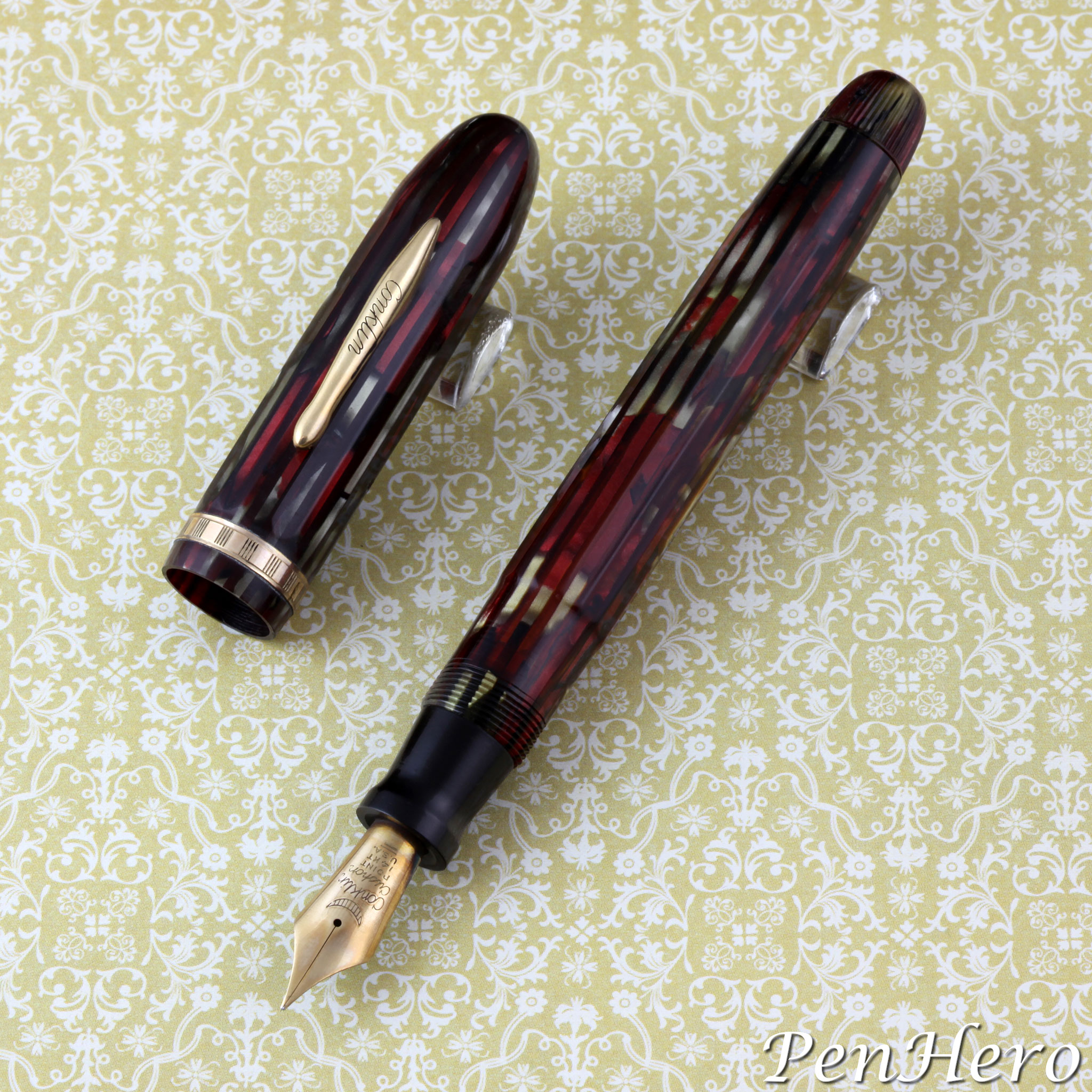 Conklin Nozac Penline Red Pearl c. 1936
Conklin Nozac Penline Red Pearl c. 1936
Andreas Bienenstein, Conklin’s most prolific patentee, submitted piston-filler designs in November 1930 and April 1931, with both awarded March 28, 1933. Conklin’s first advertisement for their new piston-filling pen can be seen in the February 21, 1931, Collier’s magazine headlined, “Announcing The Conklin Endura-Graph...A New Type Of Fountain Pen.” This may have been a trial run on the name before settling on Nozac. Conklin used the Endura name to signify the new piston-filling pen carried its Unconditional and Perpetual Guarantee. Conklin introduced the Symetrik name on early streamlined Enduras. A May 1931 Collier’s advertisement calls the piston pen the Endura Nozac, introducing the “no sac” branding. Later 1931 ads and barrel imprints combine these names, including Nozac Symetrik, Endura Nozac Symetrik, Endura Nozac, and Nozac Symetrik, before Conklin finally settled on just Nozac.
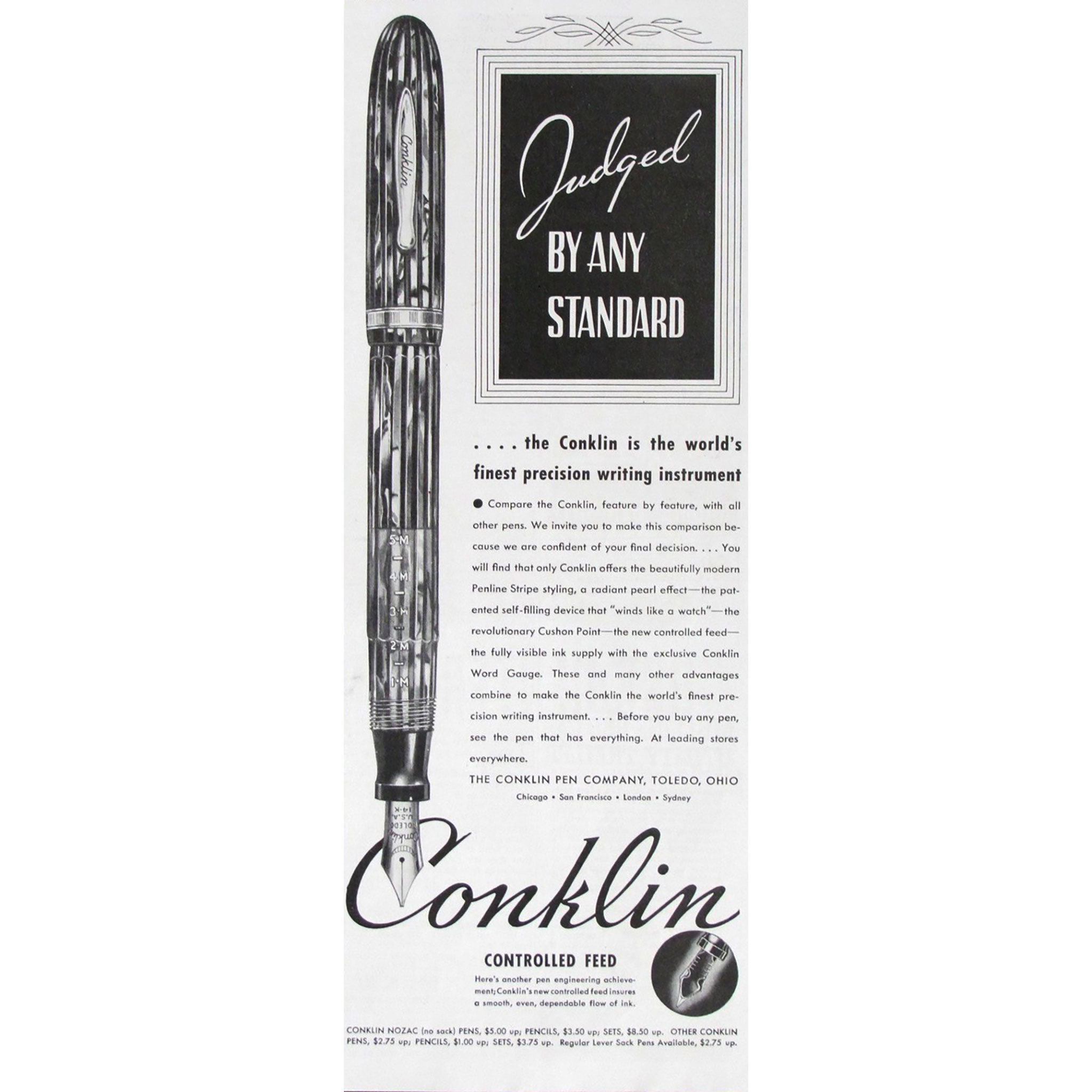 Advertisement in Collier's Weekly November 21, 1936, page 93 showing marbled Penline Nozac
Advertisement in Collier's Weekly November 21, 1936, page 93 showing marbled Penline Nozac
Nozac pens hold ink directly in the top half of the barrel, with the bottom half containing the piston-fill mechanism. They work by twisting a knob on the barrel end that operates the piston mechanism, moving a plunger inside the barrel. Clockwise turns fill the pen and counterclockwise turns empty it. Conklin advertised that operating the pen was “like winding a watch.”
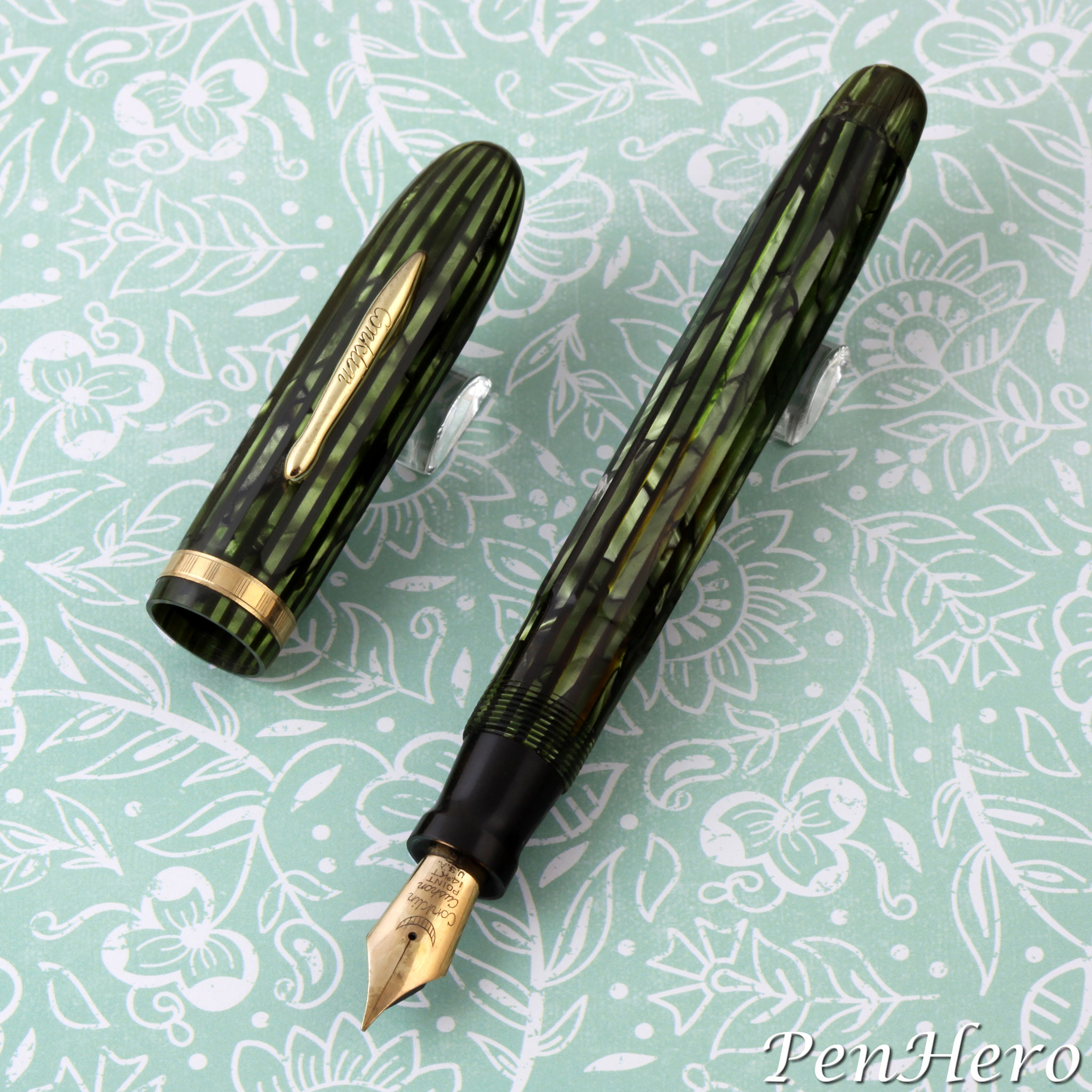 Conklin Nozac Penline Green Pearl c. 1936
Conklin Nozac Penline Green Pearl c. 1936
From earliest production to mid-1936, Nozacs were made by lathe-turning the cap and barrel from rod stock and then boring the cap and barrel so the threads, mechanism, and fittings could be installed. In 1932, Conklin began making two-piece barrels with a clear ink chamber near the nib section that screwed into an opaque end section that matched the cap color. These two shorter barrel sections made it easier to manufacture with a shorter length bore. In 1934, Conklin introduced the Word Gauge, a measure stamping on the clear barrel section reading in segments from 1M up to 7M. Conklin claimed the segments indicated how many thousands of words of writing capacity the pen had left before a refill was needed.
Nozacs Earn Their Stripes
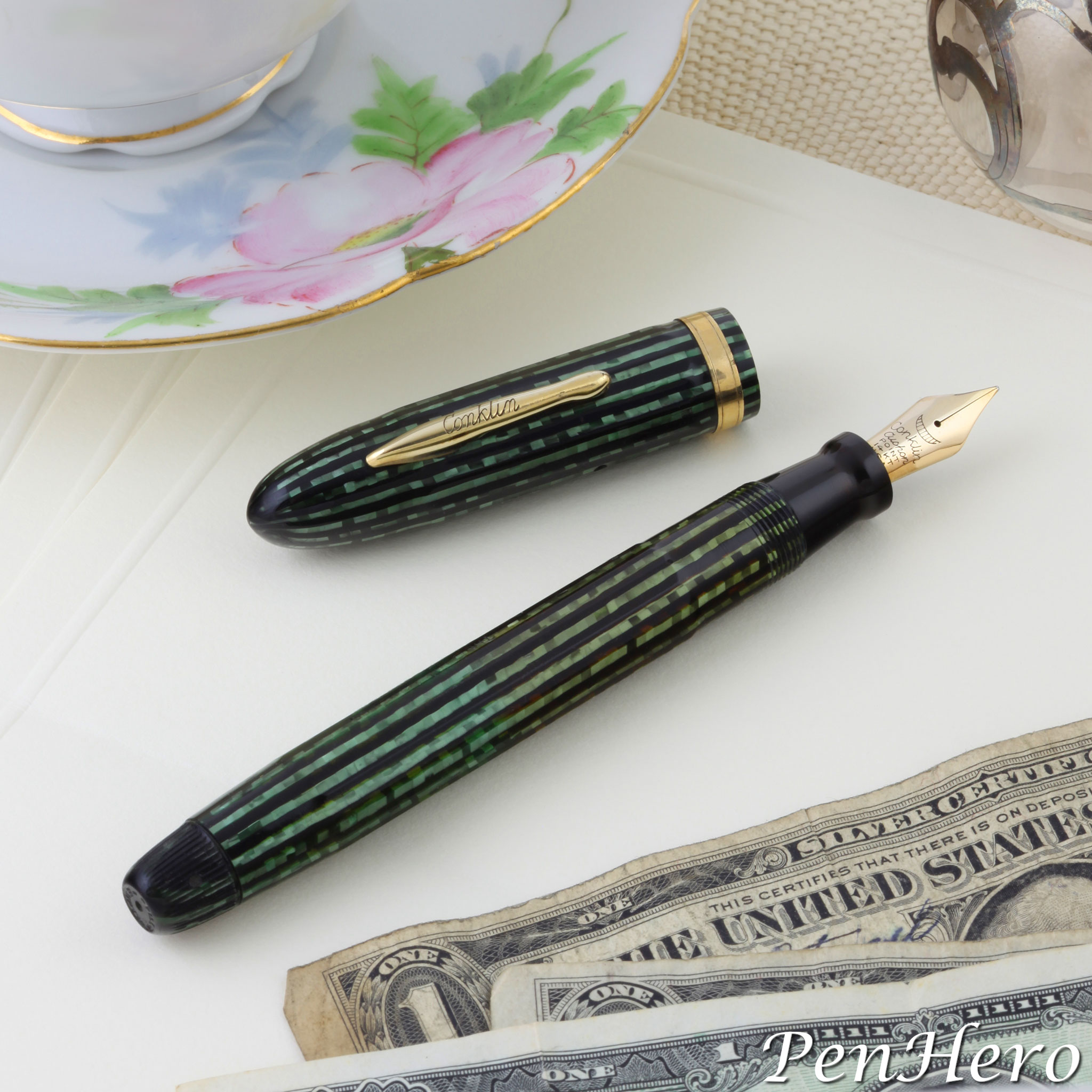 Conklin Nozac Penline Green c. 1937
Conklin Nozac Penline Green c. 1937
In September 1936, Conklin introduced two new lines, Chevron and Penline, each constructed of tubes made from sheet celluloid with repeating striped patterns. Chevron pens have plain stripes separated with rows of colored celluloid arrows running in alternating directions. Penline pens have alternating stripes of plain colored and marbled or brickwork celluloid. The sheets were wrapped into cap and barrel tubes that were then worked into finished caps and barrels. The seam can be found with careful examination. This tube construction method allowed the barrel to be a single piece with translucent stripes in the top half for viewing the ink level. The bottom half of the barrel is coated on the inside to hide the piston mechanism. The Word Gauge feature continued on these pens into 1937. Both of the new lines use Conklin’s 1936 patent clip and began the use of the new in 1936 Cushon Point nib and feed.
The “Marbled” Penline—First Generation
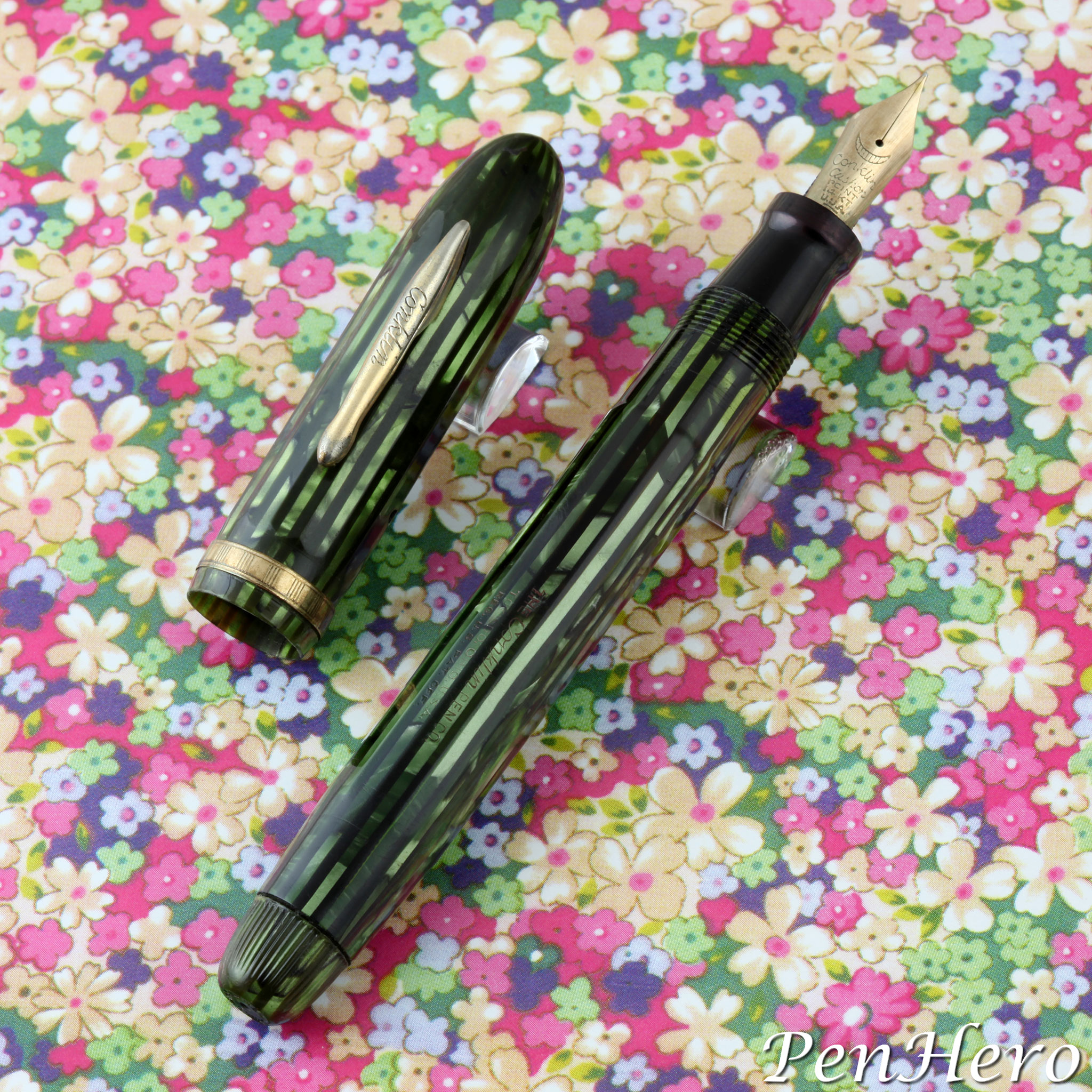 Conklin Nozac Penline Green Pearl c. 1936
Conklin Nozac Penline Green Pearl c. 1936
The first generation of Penline Nozacs were introduced in late 1936 and made in three colors, Red Pearl, Green Pearl and Gray Pearl, where the plain colored strip complemented the colored marbled celluloid stripe. They were made as a 14-sided 7,000-word version, a 12-sided 5,000-word version and short 12-sided version. Non-faceted long, slender Penline Nozacs were also made. Conklin also made Penline Quick-Fill plunger pens and Penline Sac-Type lever-fill pens using the same material.
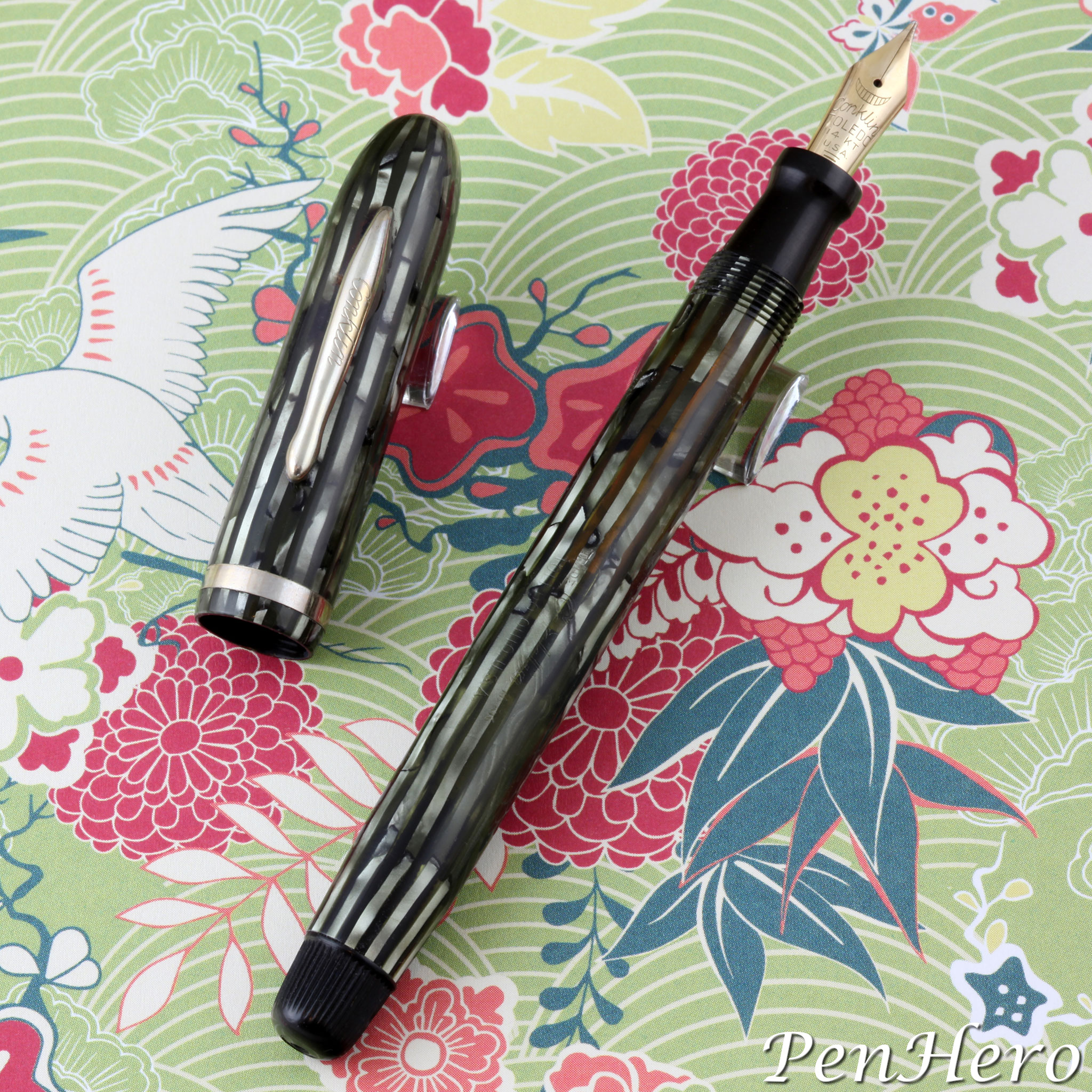 Conklin Nozac Penline Gray Pearl non-faceted barrel c. 1936
Conklin Nozac Penline Gray Pearl non-faceted barrel c. 1936
Catalogs and advertisements show first-generation Penline Nozacs offered as in the list below. Conklin clearly made variations as can be seen when many pens are examined. These may be due to custom orders, production design changes, or pens being made from available parts. The variations include pens found with earlier Toledo nibs, nib sections made from matching barrel celluloid, filler knobs made from matching barrel celluloid, and non-advertised cap bands. This list captures what’s common, cataloged or advertised as Nozacs, knowing that other versions exist. It does not cover Quick-Fill or Sac-Type pens.
Identification Guide and Features
- Celluloid cap and barrel made of alternating stripes of translucent plain colored and opaque marbled celluloid
- Colors offered were Red Pearl and Green Pearl with gold-plated trim and Gray Pearl with silver-colored plated trim
- Four sizes: 14-sided faceted 7,000-word, 12-sided faceted 5,000-word, short 12-sided faceted ladies’ pen, and non-faceted slender pen
- Faceted pens have a cap band with repeating pattern of four vertical engraved lines; non-faceted pens have plain cap band
- Conklin stamped 1936 patent clip
- Cap unscrews
- Black nib section
- Black or barrel-color piston knob
- 14 karat gold Cushon Point nib with Conklin Crescent logo
- Nib grades offered were extra-fine, fine, medium, coarse, stub medium, stub broad, left oblique, two-way, and Recorder in extra-fine, fine, and medium
- 5 1/4 inches long
- Piston-filling mechanism
- 7,000-word fountain pens sold for $7.50; 5,000-word fountain pens sold for $5.00, and matching twist-action pencils were $3.50. Shorter ladies’ pens were $7.50.
The “Brickwork” Penline—Second Generation
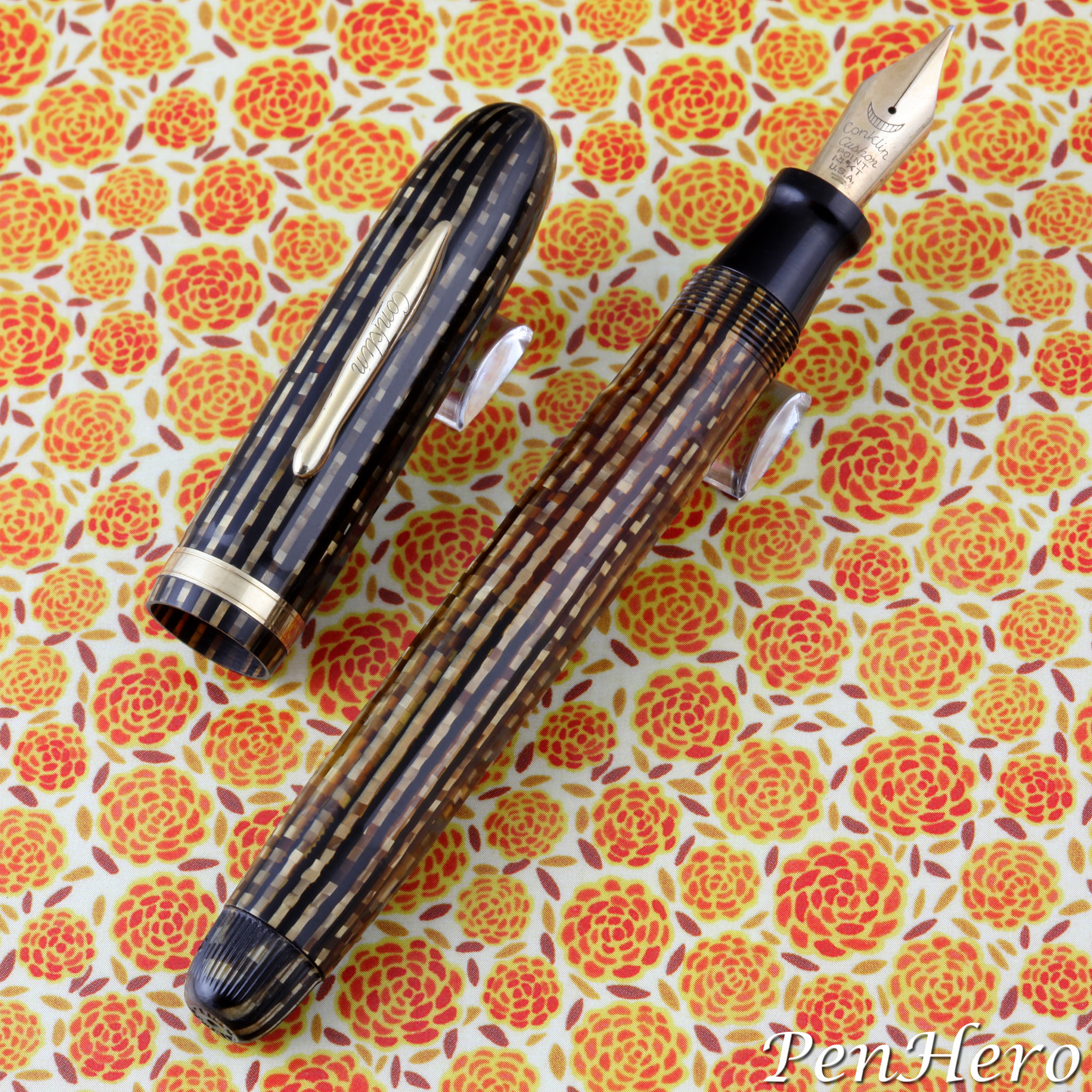 Conklin Nozac Penline Golden c. 1937
Conklin Nozac Penline Golden c. 1937
An October 23, 1937, advertisement in Collier’s announces a new look for the Penline. The new celluloid is based on a September 17, 1935, stripes and brickwork design patent by Andreas Bienenstein. The patent design shows the brick stripes with rows that have three bricks across, whereas the production pens show a single row of marbled bricks. These pens do not have the Word Gauge feature but continue to use the 1936 patent clip and the Cushon Point nib and feed.
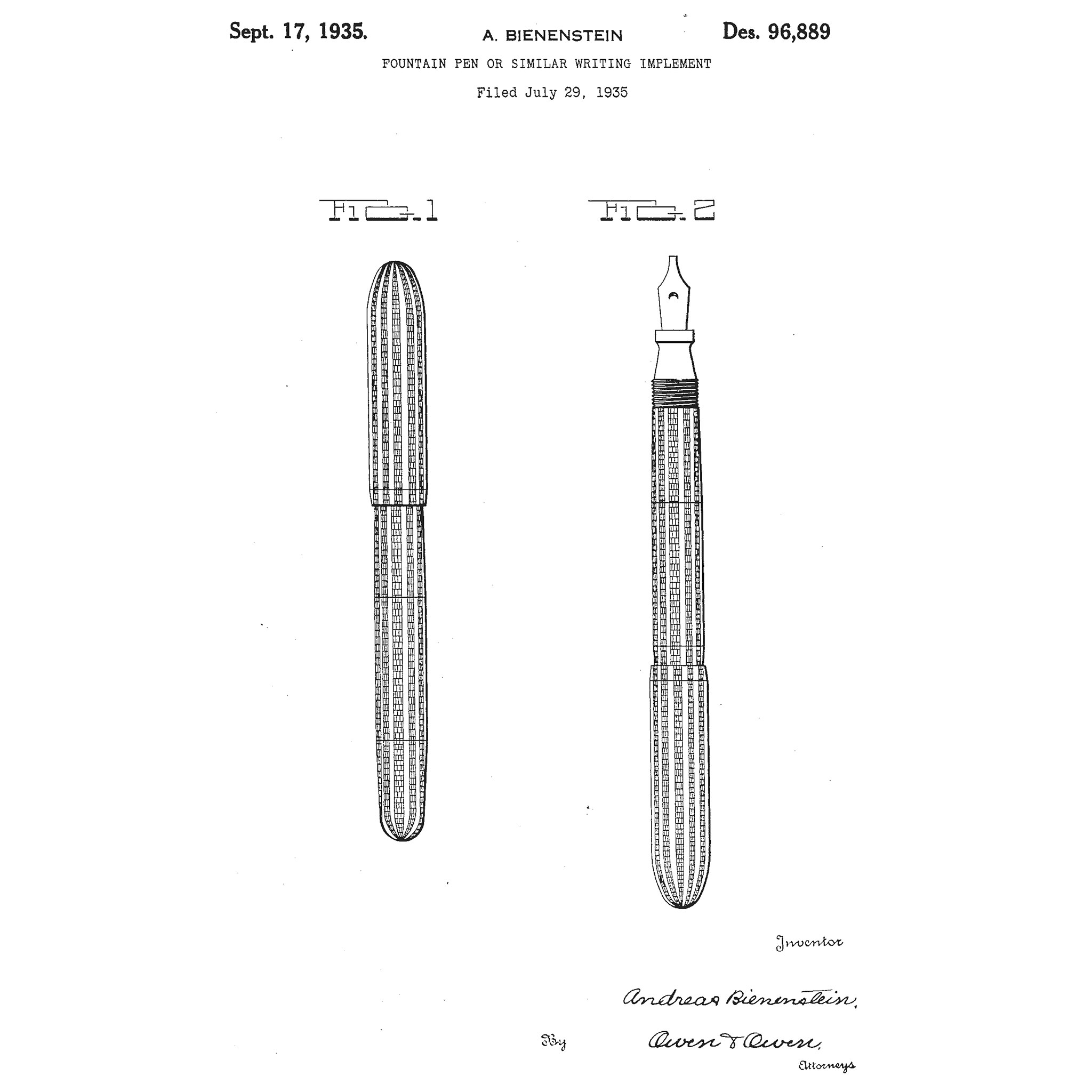 U.S. Design Patent No. D96889 awarded September 17, 1935 to Andreas Bienenstein
U.S. Design Patent No. D96889 awarded September 17, 1935 to Andreas Bienenstein
The second-generation Penline Nozacs were made from formed tubes of sheet celluloid with alternating stripes of plain colored and marbled brickwork celluloid in Red, Green, Gray and Golden. These pens were made as a 14-sided oversize version, a 12-sided standard version, and short 12-sided version. The short pen was also made in black. Conklin also made a second generation of Penline Sac-Type lever-fill pens using the same material.
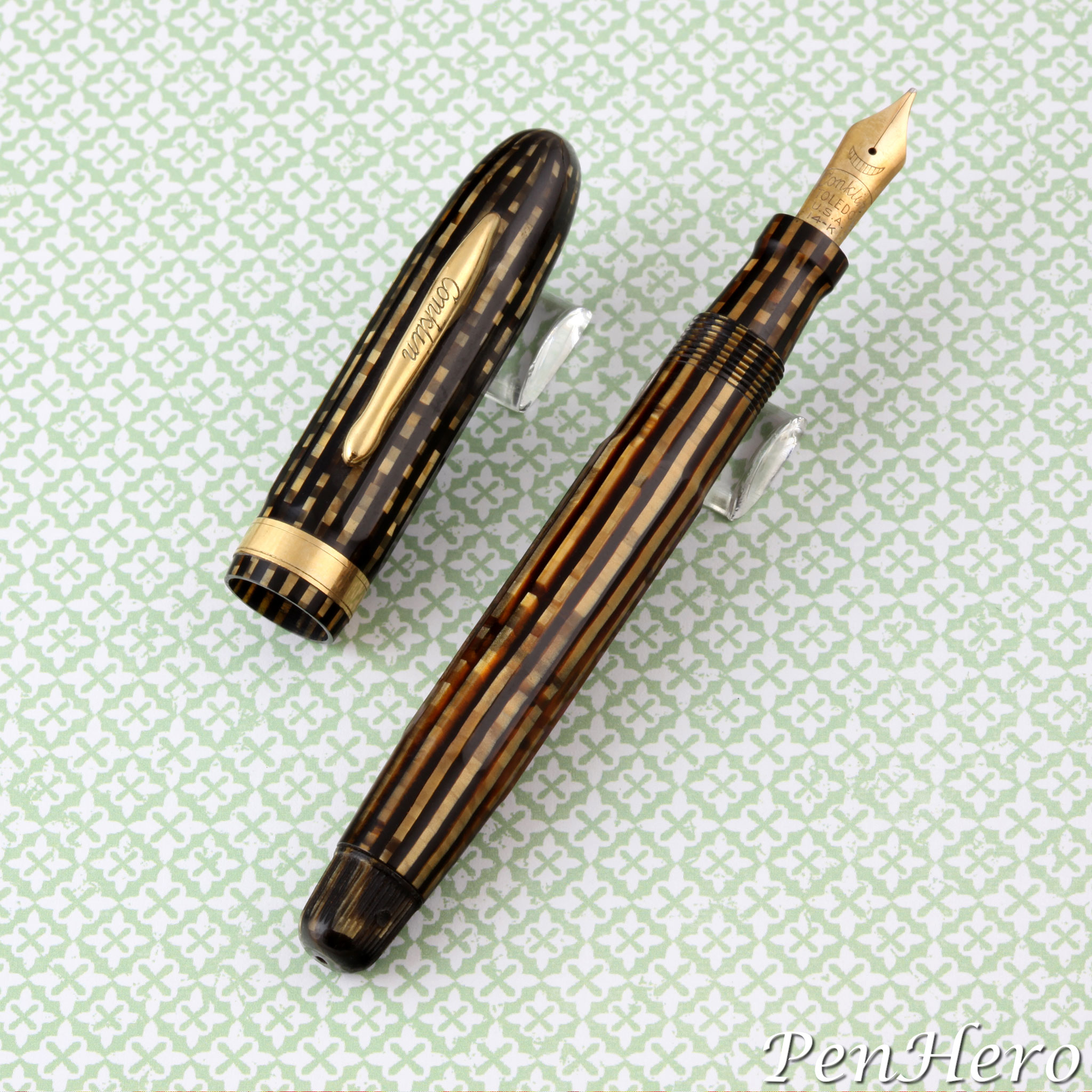 Conklin Nozac Penline Golden short model c. 1937
Conklin Nozac Penline Golden short model c. 1937
Catalogs and advertisements show second-generation Penline Nozacs offered as in the list below. As with the first-generation pens, Conklin made many variations, possibly due to custom orders, production design changes, or pens being made from available parts. Variations include examples with earlier Toledo nibs, nib sections made from matching celluloid, and non-advertised cap bands. This list captures what’s common, cataloged or advertised as Nozacs, knowing that other versions exist. It does not cover the 12-sided faceted Sac-Type pens, which sold for $5.00.
Identification Guide and Features
- Celluloid cap and barrel made of alternating stripes of plain colored and marbled brickwork celluloid
- Colors offered were Red, Green, and Golden with gold-plated trim and Gray with silver-colored plated trim
- Black with gold-plated trim was offered on the short 12-sided version, which has a clear visulated upper barrel and has the two-line cap band
- Three sizes: 14-sided faceted oversize, 12-sided faceted standard, and short 12-sided faceted ladies’ pen
- Cap band has single engraved line near the top and bottom edge
- Conklin stamped 1936 patent clip
- Cap unscrews
- Black nib section
- Black or barrel color piston knob
- 14 karat gold Cushon Point nib with Conklin Crescent logo
- Nib grades offered were extra-fine, fine, medium, coarse, stub medium, stub broad, left oblique, two-way and Recorder in extra-fine, fine, and medium
- 5 1/4 inches long
- Piston-filling mechanism
- Oversize fountain pens sold for $7.50, standard fountain pens sold for $5.00, and matching twist action pencils were $3.50. The short model Penline Nozac pens were $7.50.
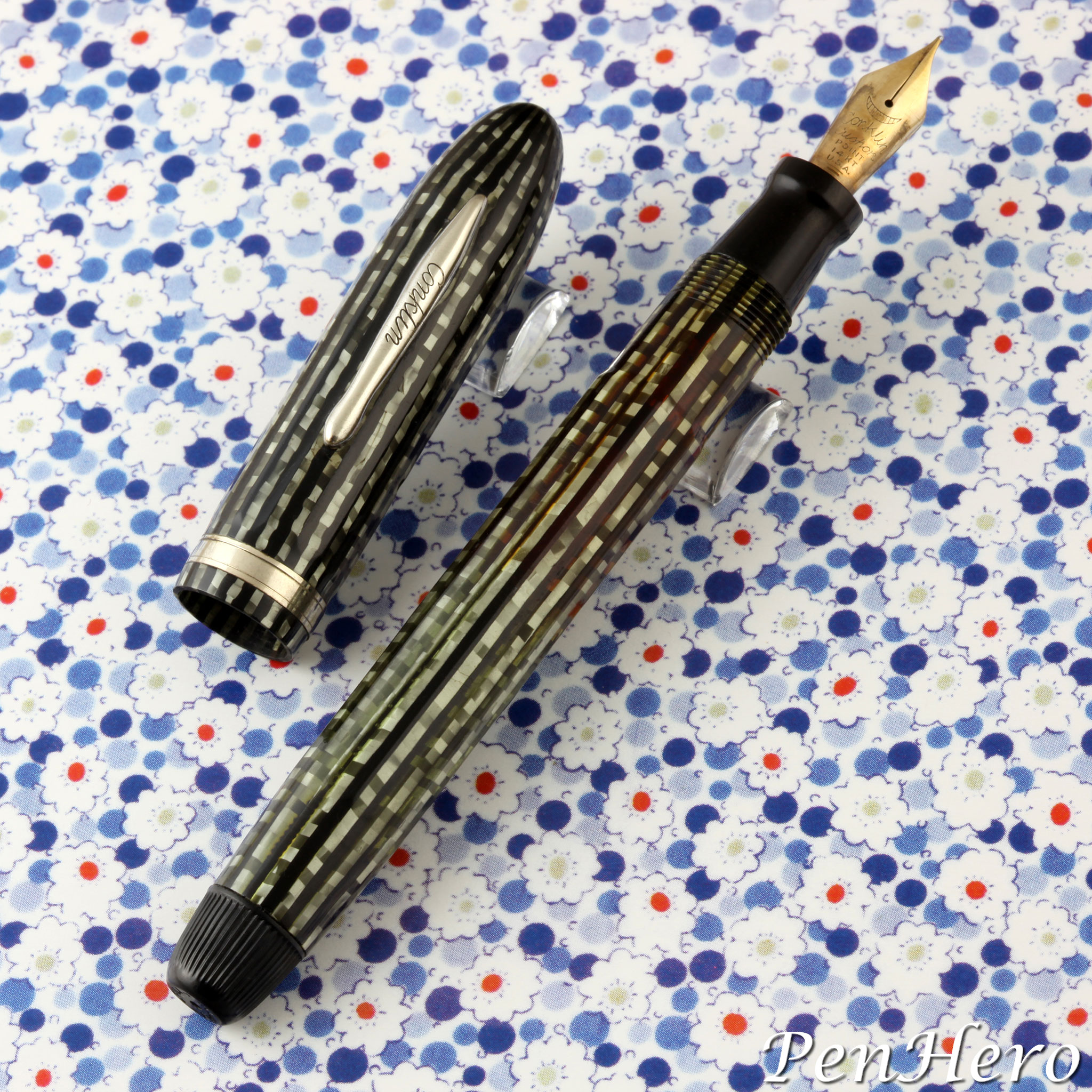 Conklin Nozac Penline Gray c. 1937
Conklin Nozac Penline Gray c. 1937
Evidence of Conklin’s financial troubles can be seen beginning in a series of newspaper advertisements offering at first Chevron models in late 1937 and by late 1938 more models, including second-generation Penline models at 50% or greater discounts. The company was sold to a Chicago Syndicate consisting of A. J. Parrson, M. H. Jacobs, and Max Horwitz on July 13, 1938.
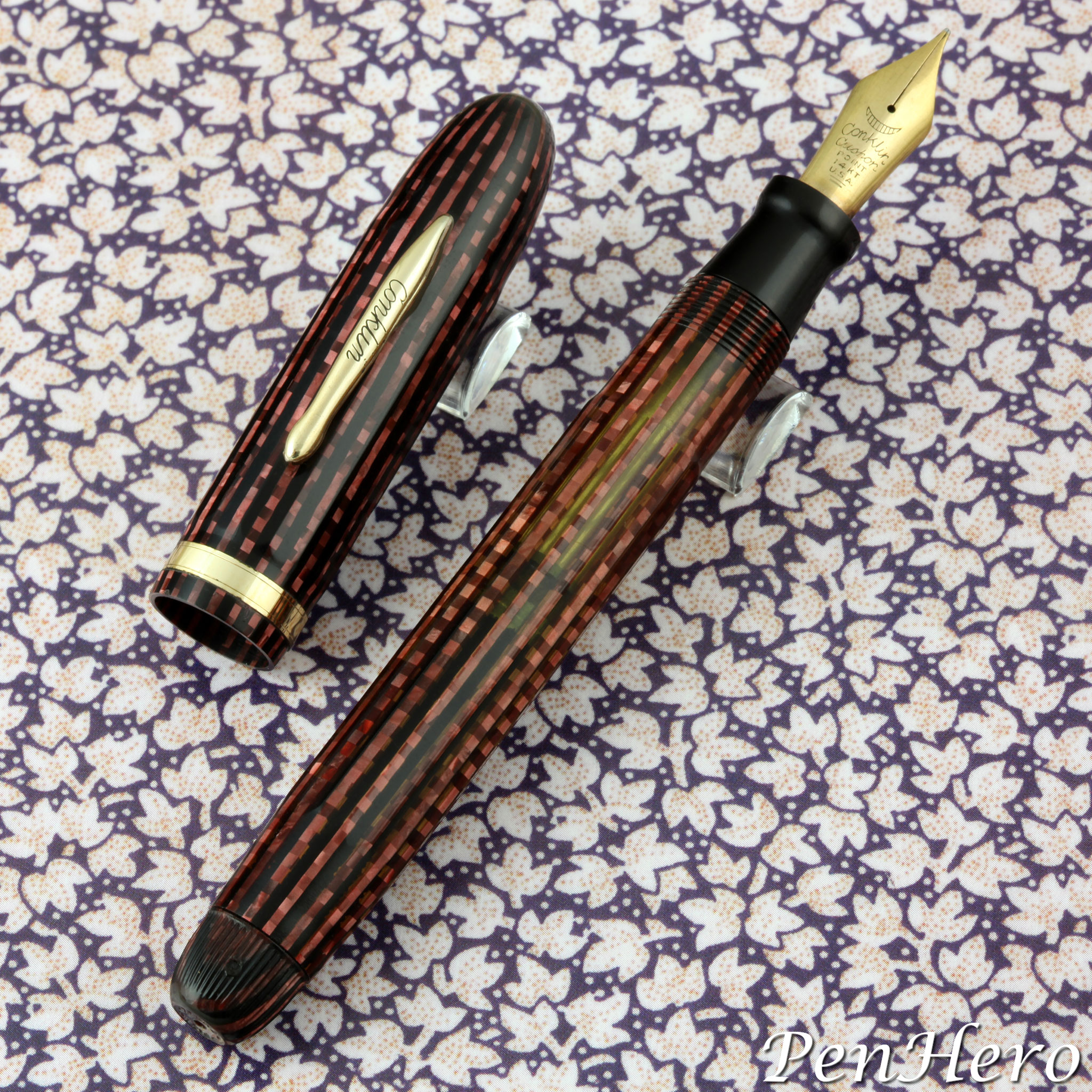 Conklin Nozac Penline Red c. 1937
Conklin Nozac Penline Red c. 1937
Performance
Most of the pens shown in this article were loaned for photos. I actually acquired the green brickwork Penline Nozac back in 2002 and it has held a prime spot in my collection, though it does not see a lot of use. There are a lot of 1930s striped celluloid pens, but Penline Nozacs stand out with their faceted caps and barrels and their choice of celluloid colors and patterns. A good restored example will have a clear ink chamber at the top of the barrel, the piston mechanism will turn freely and visibly advance and retract, and it will draw water without leaking. They are fairly standard size for the period at about 5 1/4 inches long capped and 6 1/8 inches posted. They post reasonably securely on the end of the barrel, but not tightly enough for vigorous writing. Considering their age, I don't post these pens to avoid cap cracks. The spring loaded clip is very nice and works like a clothespin. Its position on the cap makes the pen ride high in the pocket.
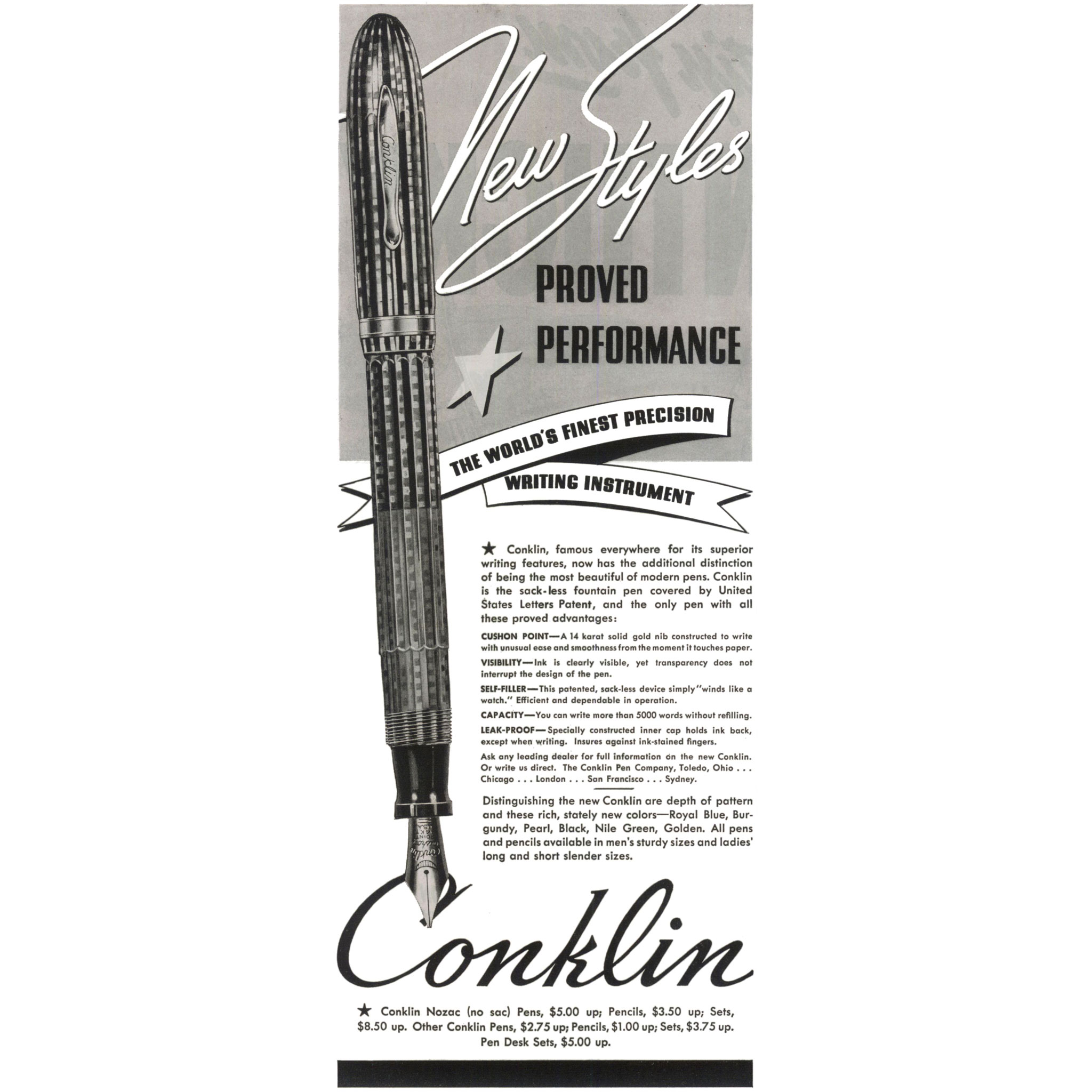 Advertisement in Collier's Weekly October 23, 1937, page 62 showing brickwork Penline Nozac
Advertisement in Collier's Weekly October 23, 1937, page 62 showing brickwork Penline Nozac
The Nozac fills by twisting the filler knob until the plunger is at the top of the barrel, dunking the nib into the inkwell, and twisting until the pen slowly sucks up the ink. The windowed barrel gives a similar view of the ink level as contemporary Sheaffer Vacuum-Fill pens. The Cushon Point nib on this example inks paper on contact with wet, smooth strokes and a little flex. The fit and finish, gold plating and detailing of these pens is first rate. They are fairly light in the hand.
Nozacs are going to be less common and higher priced than other pens from the same period. In my experience, Penline models seem to be easier to find and less expensive than Chevron models.
The biggest issue with Conklin Nozacs is going to be restoration, which requires expertize and access to parts if needed. A fully restored pen will be considerably more expensive than an unrestored pen of the same model. Beware that some non-working piston fillers may not be restorable and would serve only as parts pens. Some key questions for an unrestored Nozac include barrel clarity, if the piston moves up and down easily, if there are any cracks in the cap lip or barrel, and if the clip opens and closes tightly. When in doubt, ask a Conklin Nozac repair person.
In spite of the potential risks, a restored, well adjusted Nozac can be a great writer and a highlight to a collection. They hold a lot of ink and the faceted pens feel great in the hand. If your budget is limited, try to find a restored user grade pen and have fun with it!
Acknowledgements
Many thanks Pete Kirby and Dave Glass for their invaluable help on facts and history of Conklin Nozacs.
Pennant Fall 2018
This story appeared in the fall 2018 Pennant, the magazine of the Pen Collectors of America (PCA). You can learn more about joining the PCA and subscribing to the Pennant by clicking the link.
References
Collier’s, February 21, 1931, Conklin Endura-Graph advertisement
Collier’s, May 23, 1931, Conklin Endura Nozac advertisement, page 55
Collier’s, November 21, 1936, Conklin Nozac Penline marbled advertisement, page 93
Collier’s, October 23, 1937, Conklin Nozac Penline brickwork advertisement, page 62
Conklin 1936 Catalog
Conklin 1937 Catalog
Indian Valley Record, Greenville, California, September 24, 1936, Conklin “Made With Watch-Like Precision” advertisement
New York Daily News, December 1, 1937, page 9
Pittsburgh Post-Gazette, September 8, 1938, page 5
Saturday Evening Post, November 21, 1936, page 93, Conklin “Judged By Any Standard” advertisement
The Cincinnati Enquirer, July 14, 1938, page 16
"The Piston Filling Mechanism" from the Pelikan official website, copyrighted
U.S. Design Patent No. D96889 awarded September 17, 1935 to Andreas Bienenstein
U.S. Design Patent No. D99262 awarded April 14, 1936 to Andreas Bienenstein
U.S. Patent No. 1706616A filed September 15, 1927 and September 28, 1926 in Germany and awarded March 26, 1929 to Theodor Kovács
U.S. Patent No. 1902809A awarded March 28, 1933 to Andreas Bienenstein
U.S. Patent No. 1902810A awarded March 28, 1933 to Andreas Bienenstein
Interact
Comments on this article may be sent to the author, Jim Mamoulides


